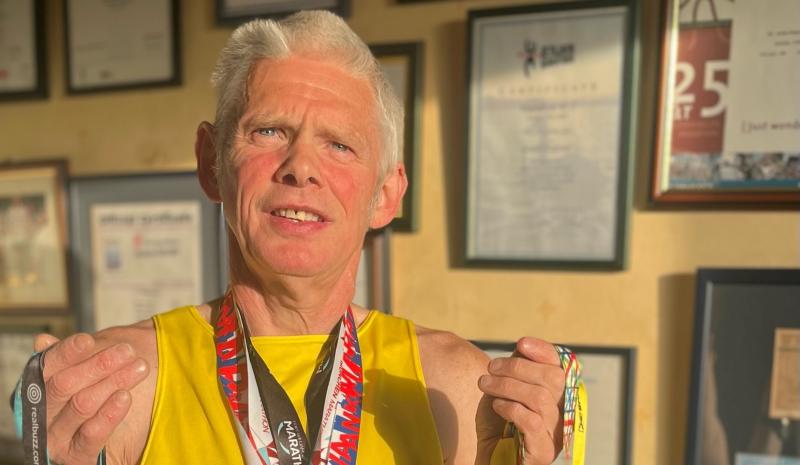News
Connemara patients waiting up to four hours for ambulance

A Clifden GP has hit out at the slow response times of ambulances which he insists are endangering the lives of seriously ill patients across Connemara.
In a letter submitted by the Leenane and Maam Ambulance Steering Group to Oireachtas members to campaign for an improved service, Dr John Casey Junior outlined cases involving his patients who were forced to wait hours for an ambulance.
In one incident, a 50-year-old woman visiting the area presented with severe acute abdominal pain, was extremely unstable and in a lot of pain. It took three hours for an ambulance to arrive, during which time the patient had to be given morphine intravenously. She then had to face into a journey of up to 90 minutes to reach University Hospital Galway (UHG).
Another man at Clifden Community School was suffering epileptic fits every 15 minutes. His ambulance did not arrive for at least two-and-a-half hours.
“Amazingly this gentleman survived this episode, but given the fact of his presenting condition there is no doubt in my mind that his survival was a minor miracle.”
A patient in 2011 who presented with sudden stroke was not as lucky.
“By the time he made it into Galway, the four-hour window had passed and unfortunately it was too late to receive the clot busting drug that would have potentially saved him from severe disability. He is now unfortunately residing in a nursing home.”
Dr Casey wrote that he had enormous respect for the National Ambulance Service and in his six years stationed in Connemara he has found the local crew to be extremely professional and caring.
“However there is no doubt in my mind that far too often there are patients who are not getting the immediate care that they need due to the lack of services.”
He pointed out that two ambulances cover the entire Connemara area, one in the south, stationed at Carraroe, and the second in Clifden, leaving North Connemara exposed. These two ambulances leave Connemara during busy times, particularly on weekends to cover urban areas such as Galway and Castlebar.
Figures on 999 ambulance response times from last year show that just over a third of life-threatening cardiac or respiratory cases in the west were responded to within 19 minutes for the month of July – the worst month of the year for response times.
The 19-minute target for 85% of cases is the standard set by the Health Information and Quality Authority (HIQA) for “echo” calls. In the west that target was not reached for the entire year.
The best performing month for the service was September, when 83% of incidents were responded to within 19 minutes. The worst was July when just 37% of rigs arrived on the scene in that timeframe.
For five months of the year, half of the ambulances arrived outside of that critical window.
The response times were even slower for incidents classified as delta emergency calls, which are life-threatening cases not involving cardiac or respiratory complaints. The percentage of calls answered within 19 minutes reached 51% for November, the best performing month of 2014.
The Leenane and Maam ambulance steering group said the cases outlined by Dr Casey show that response times are totally unacceptable and fall far short of the recognised standards. They are calling for greater investment for the region.
“We feel that we have highlighted a failing in the system regarding availability of ambulances in the Connemara area. We all appreciate the work carried out by the National Ambulance Service but they can only work within the confines of the budgets as set out by the Government,” said PJ Leavy.
In March, Fine Gael Galway West TD, Seán Kyne, said an investment of €5.4 million for 50 new paramedic posts will boost ambulance services in the west.
The investment will see an additional eleven paramedics allocated to the ambulance base in Tuam and eleven will be allocated to Mulranny, which were highlighted in internal reports as being poorly served and ‘ambulance black spots’.
Connacht Tribune
West has lower cancer survival rates than rest

Significant state investment is required to address ‘shocking’ inequalities that leave cancer patients in the West at greater risk of succumbing to the disease.
A meeting of Regional Health Forum West heard that survival rates for breast, lung and colorectal cancers than the national average, and with the most deprived quintile of the population, the West’s residents faced poorer outcomes from a cancer diagnosis.
For breast cancer patients, the five-year survival rate was 80% in the West versus 85% nationally; for lung cancer patients it was 16.7% in the west against a 19.5% national survival rate; and in the West’s colorectal cancer patients, there was a 62.6% survival rate where the national average was 63.1%.
These startling statistics were provided in answer to a question from Ballinasloe-based Cllr Evelyn Parsons (Ind) who said it was yet another reminder that cancer treatment infrastructure in the West was in dire need of improvement.
“The situation is pretty stark. In the Western Regional Health Forum area, we have the highest incidence of deprivation and the highest health inequalities because of that – we have the highest incidences of cancer nationally because of that,” said Cllr Parsons, who is also a general practitioner.
In details provided by CEO of Saolta Health Care Group, which operates Galway’s hospitals, it was stated that a number of factors were impacting on patient outcomes.
Get the full story in this week’s Connacht Tribune, on sale in shops now, or you can download the digital edition from www.connachttribune.ie. You can also download our Connacht Tribune App from Apple’s App Store or get the Android Version from Google Play.
Connacht Tribune
Marathon Man plans to call a halt – but not before he hits 160 races

On the eve of completing his 150th marathon, an odyssey that has taken him across 53 countries, Loughrea’s Marathon Man has announced that he is planning to hang up his running shoes.
But not before Jarlath Fitzgerald completes another ten races, making it 160 marathons on the occasion of his 60th birthday.
“I want to draw the line in 2026. I turn 57 in October and when I reach 60 it’s the finishing line. The longer races are taking it out of me. I did 20 miles there two weeks ago and didn’t feel good. It’s getting harder,” he reveals.
“I’ve arthritis in both hips and there’s wear and tear in the knees.”
We speak as he is about to head out for a run before his shift in Supervalu Loughrea. Despite his physical complaints, he still clocks up 30 miles every second week and generally runs four days a week.
Jarlath receives injections to his left hip to keep the pain at bay while running on the road.
To give his joints a break, during the winter he runs cross country and often does a five-mile trek around Kylebrack Wood.
He is planning on running his 150th marathon in Cork on June 4, where a group of 20 made up of work colleagues, friends and running mates from Loughrea Athletics Club will join him.
Some are doing the 10k, others are doing the half marathon, but all will be there on the finishing line to cheer him on in the phenomenal achievement.
Get the full story in this week’s Connacht Tribune, on sale in shops now, or you can download the digital edition from www.connachttribune.ie. You can also download our Connacht Tribune App from Apple’s App Store or get the Android Version from Google Play.
CITY TRIBUNE
Galway ‘masterplan’ needed to tackle housing and transport crises

From the Galway City Tribune – An impassioned plea for a ‘masterplan’ that would guide Galway City into the future has been made in the Dáil. Galway West TD Catherine Connolly stated this week that there needed to be an all-inclusive approach with “vision and leadership” in order to build a sustainable city.
Deputy Connolly spoke at length at the crisis surrounding traffic and housing in Galway city and said that not all of the blame could be laid at the door of the local authority.
She said that her preference would be the provision of light rail as the main form of public transport, but that this would have to be driven by the government.
“I sat on the local council for 17 years and despaired at all of the solutions going down one road, metaphorically and literally. In 2005 we put Park & Ride into the development plan, but that has not been rolled out. A 2016 transport strategy was outdated at the time and still has not been updated.
“Due to the housing crisis in the city, a task force was set up in 2019. Not a single report or analysis has been published on the cause of the crisis,” added Deputy Connolly.
She then referred to a report from the Land Development Agency (LDA) that identified lands suitable for the provision of housing. But she said that two-thirds of these had significant problems and a large portion was in Merlin Park University Hospital which, she said, would never have housing built on it.
In response, Minister Simon Harris spoke of the continuing job investment in the city and also in higher education, which is his portfolio.
But turning his attention to traffic congestion, he accepted that there were “real issues” when it came to transport, mobility and accessibility around Galway.
“We share the view that we need a Park & Ride facility and I understand there are also Bus Connects plans.
“I also suggest that the City Council reflect on her comments. I am proud to be in a Government that is providing unparalleled levels of investment to local authorities and unparalleled opportunities for local authorities to draw down,” he said.
Then Minister Harris referred to the controversial Galway City Outer Ring Road which he said was “struck down by An Bord Pleanála”, despite a lot of energy having been put into that project.
However, Deputy Connolly picked up on this and pointed out that An Bord Pleanála did not say ‘No’ to the ring road.
“The High Court said ‘No’ to the ring road because An Bord Pleanála acknowledged it failed utterly to consider climate change and our climate change obligations.
“That tells us something about An Bord Pleanála and the management that submitted such a plan.”
In the end, Minister Harris agreed that there needed to be a masterplan for Galway City.
“I suggest it is for the local authority to come up with a vision and then work with the Government to try to fund and implement that.”












